You’d think that finding a dot in music could be just one simple answer. And while the answer is simple, there is more than one answer! So depending on where you find the dot in your music, you will have a different answer. Let’s take a look at what you may be seeing:
-
Staccato: if the dot is above or below the note
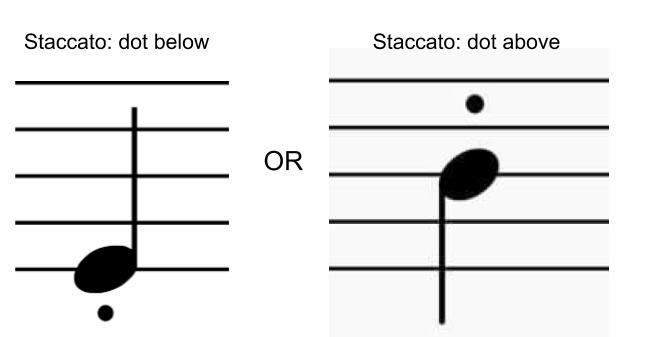
-
Dotted Note: if the dot is next to a note
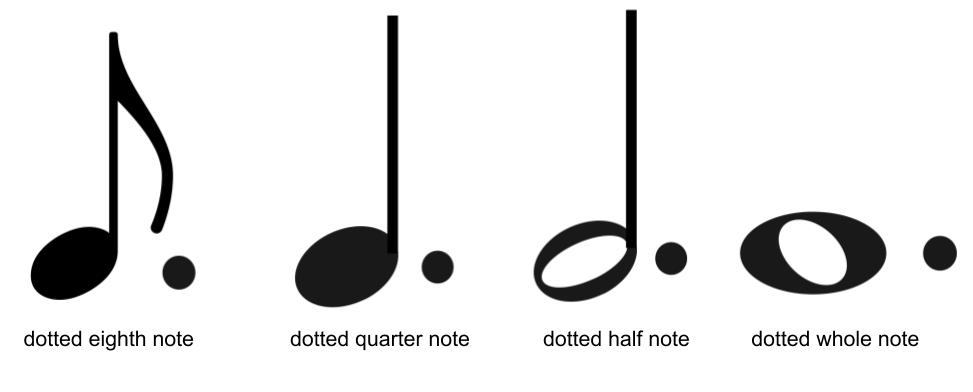
-
Dotted Rest: if the dot is next to a rest

-
Double Dotted: if there is more than one dot after a note or rest
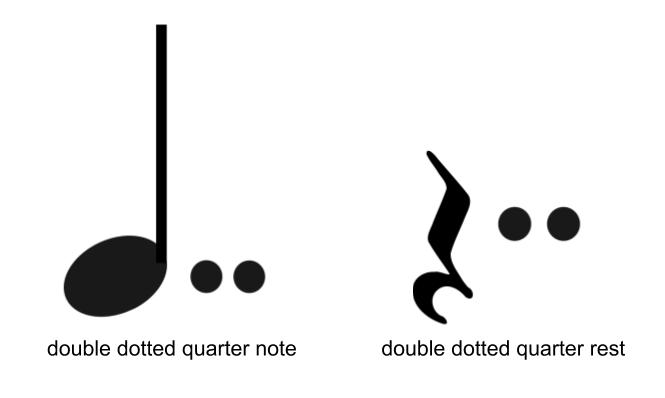
-
Fermata: if the dot is under a half circle
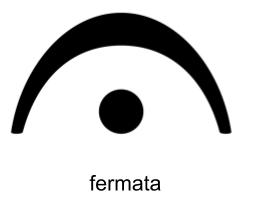
Staccato
If the dot is either above or below the note, then it is called staccato. It is what we call, an articulation. What that means is simply, how you play it. It doesn’t affect anything but the way you play the note. For staccato, you play the note “short” or “quick”. You need to understand, though, that it does NOT change how fast or slow you play the note, just that it sounds short.
The opposite of staccato is legato. Legato means to play it smooth. It is easier to understand staccato when you can understand legato. You want to play staccato the opposite of smooth.
When I am introducing staccato to my students, I like to say staccato like so, “stuh – caw – toe”. It helps to remember to play it like it sounds, short and choppy.

Staccato can be shown being written either above the note or below the note. They are one and the same meaning regardless of it is on top or below the note. They write the dot above the note if the stem is pointing down. The dot is below the note when the stem is pointing up.
Dotted Notes and Rests
There is a BIG difference that occurs if the dot is written next to a note versus on top or below a note. While staccato determines how you play the note, a dot next to a note determines how long you play the note. A dot determines the rhythm of a note.
What’s so cool about the dot after a note or a rest, is that it can be used on any note or rest. You can find a dot after any rest, or after any note. The most common notes/rests that you find a dot after are after a quarter note/rest, or a half note/rest.
The dot can seem very confusing, but in reality it really isn’t. It just has one rule to remember with it! So don’t forget it:
The dot is worth half of whatever the note or rest is. It’s as simple as that.
Let’s take a quarter note for example. A quarter note is worth 1 count. So the dot after that is worth half of the note in front of it, and since that is 1, the dot is worth 1/2. Since the quarter note is worth 1 and the dot is worth 1/2, a dotted quarter note is worth 1 and 1/2 counts.
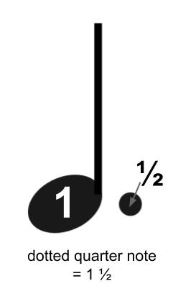
The same applies for all of the notes and rests. The dot is just half of whatever the note/rest in front of it is. Then add the note/rest with the dot to find the total amount it is worth.


Double Dotted Notes and Rests
Since you already know the rule for the dot, then you can easily figure out any amount of dots you may find in your music. The same rule applies:
The dot is worth half of whatever the note or rest or dot that is in front of it.
Check this out.

The quarter note is worth 1 count, the dot after that is worth 1/2 of 1, and the dot after that is worth 1/2 of 1/2, or 1/4. Add those together and in total, it is worth 1 and 3/4 count.
The whole rest is worth 4, the dot after the whole rest is worth 1/2 of 4, so 2. The dot after the dot is worth 1/2 of 2, so 1. Add 4+2+1 = 7 counts.
You can continue to add as many dots as you want. Although you really don’t see double dots much unless you are getting into advanced music playing.
Fermata
Lastly, you may be looking at a dot under a half circle. This is what my students call a bird’s eye. They can never seem to remember the word, fermata, but by golly they sure remember to call it a bird’s eye!
A fermata can be found above a note or a rest.

It simply means to hold out the note as long as you want to. You, as the player or singer, can hold it as long as deems you good.
Sometimes, I have students that don’t like to hold it at all. They just skim right over it. I wouldn’t suggest that, since it is the composer’s idea to hold it for some type of length of time. But neither do I suggest holding it forever and ever. Sometimes it just depends on the context and where you can find it in the music.
No matter what kind of dot you found in your music, you should have a clear idea of what to do with it now!
Learn to Play Piano
An increasingly popular option for learning piano is using chords to play whatever you want. It is a quick method of learning that can help you go far in your playing. Pianoforall uses this method and has had incredibly positive results.
Pianoforall is an online piano course for a one time, phenomenal price that will benefit them for life as it has free updates for life. It has over 200 videos and lessons, but what piano students will also love is the 9 e-books that let them explore other music styles. You can choose what you want to learn and go for it!
I highly recommend you checking out Pianoforall. It has been used over and over (with over a quarter million students) by piano students since 2006 and it is the best course you can take online for its incredible value. 60 days, money back guarantee, and even then, it has a return rate below 4%. It is extremely affordable with only a one time payment and free updates for life.
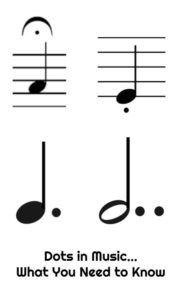
Tel loves her life as a piano player, a piano teacher, and a mom. Amid piano blogging, piano teaching, and piano playing, she loves a chance to fit in a good exercise class, volunteer at her kids’ school and at her church, and go on long dates with her husband. Full bio at About Tel.


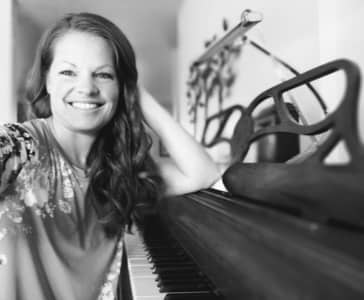
WHY IS IT THAT A DOTTED EIGHTH NOTE RECIVES 1 AND 1/4…
WHEN THE HALF OF 1/2 IS 1/4 ADDED TOGHETHER EQUALS
3/4 NOT 1 AND 1/4????
Thanks for pointing that out! I fixed that and it should show correctly now!
What does it mean when the dot is next to the stem of the note, as in MM 10 etc in the Moonlight Sonata second movement. Presumably that just means staccato, and the dot is placed there becuase there is no room for it above the note head?
It’s hard to say for sure without being able to see it, but if the dot is truly right next to the note, then the dot would represent how long to hold that note. A dot next to a note is always worth half of the note proceeding it. Hopefully that helps!
So what does it mean if I have a dotted eighth note, indicating BPM? Like this:
♩. = 60
I could never understand why or the reason a note breaks when attached to another, such as (half note) C combined with D (half note) (mixed with a (16th note). What is it?